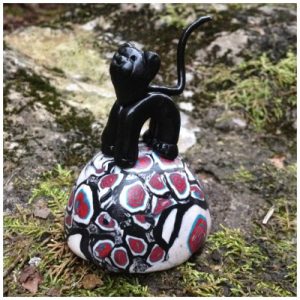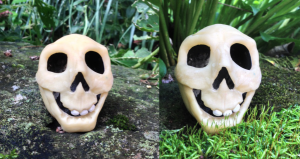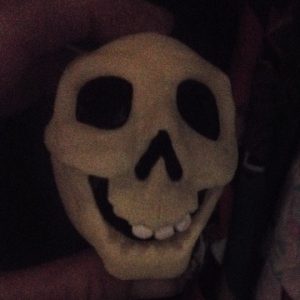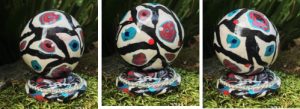This egg was certainly fun to make. I used the roundest of the chicken eggs I had previously blown the contents from, then made wedges (thicker center than edges) to put around the equator of the egg top to bottom making the egg appear rounder and giving the pumpkin ridges. I smoothed the wedges together and before curing i scored the areas for the eyes and nose and mouth and teeth and the top scallop where I could cut out the top. the hole in the egg (to let the hot air escape during curing so as not to cause bubbles) was saved for the stem. I sanded the egg lightly then cut the eyes and nose and mouth and top part out using a razor blade, trying not to break the whole egg.
After pieces were separated I used a blade to carve the edges clean, and sanded smoother (i didn’t sand this as smooth as i could have…. I am not that good a craftsman and bore too easily). After sanding, i made the eyes of black polymer clay and added the stem to the lid, put a black ring for a stand, made a small candle which I placed in the interior and cured the egg again. After some more sanding, I sprayed some fluorescent yellow paint into a plastic cup (one from the sampling at Kroger LOL, that I would feign to throw out) and painted the inside of the pumpkin (white eggshell still present acted as a nice white base color).
In the sunlight the eyes mouth and nose show up pretty nicely. It is a fun idea, and would be a good craft for the kids.




 se areas, and sanded around and chipped some more. I then added the mandible and ridges over the eyes and zygoma and figured in where the teeth should go, and cured it again. Lastly, I added the three teeth (the hardest part, ha ha), cured again, and painted with black and brown acrylic paint the inside of the head. I thought about using pencil or ink to mark in the cranial sutures and foramina… ha ha. I am not totally sure why this guy looks so smiley for a skull.
se areas, and sanded around and chipped some more. I then added the mandible and ridges over the eyes and zygoma and figured in where the teeth should go, and cured it again. Lastly, I added the three teeth (the hardest part, ha ha), cured again, and painted with black and brown acrylic paint the inside of the head. I thought about using pencil or ink to mark in the cranial sutures and foramina… ha ha. I am not totally sure why this guy looks so smiley for a skull.





